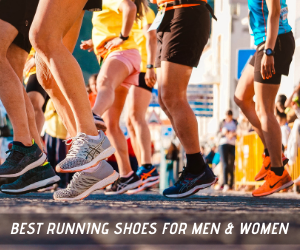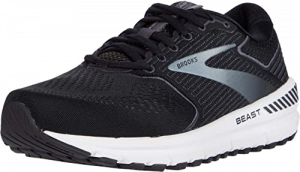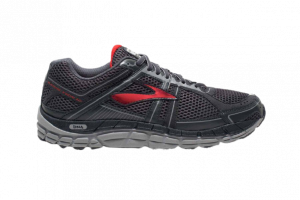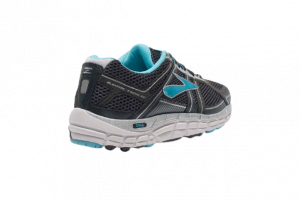 Running shoes are designed to optimize a runner’s gait in such a way that a person can run longer and faster without worrying about injury. (Note: Gait is the pattern of movement of the limbs of humans, during locomotion over a solid substrate.)
Running shoes are designed to optimize a runner’s gait in such a way that a person can run longer and faster without worrying about injury. (Note: Gait is the pattern of movement of the limbs of humans, during locomotion over a solid substrate.)
You are not sure How To Choose Right Running Shoes for you.
You are worried about getting injured or the wrong shoes.
Keep readding on how to choose running shoes, and learn how to pick the best pair of running shoes for your needs.
Contents
- The basic construction of running shoes:
- Our Savings For Running Shoes [Deals]
- Buying Guide: Things to consider when Choosing running shoes
- Three different foot types:
- Running Shoe Sizes
- Running shoes for men and women
- Recommended Running Shoes For Male Overpronators:
- 1. Brooks Men’s Beast Running Shoe
- 2. Brooks Men’s Addiction 12 Running Shoe
- Recommended Running Shoes For Female Overpronators:
- 1. Saucony Women’s ProGrid Stabil CS2 Running Shoe
- 2. Brooks Women’s Addiction 12 Running Shoe
- Recommended Running Shoes For Male Underpronators:
- 1. New Balance Men’s MR890 Running Shoe
- 2. ASICS Men’s GEL-Nimbus 14 Running Shoe
- Recommended Running Shoes For Female Underpronators:
- 1. ASICS Women’s Gel-Nimbus 19 Running Shoe
- 2. Mizuno Women’s Wave Rider 15 Running Shoe
The basic construction of running shoes:
Outsole – This is the bottom of the shoe with a durable slab of rubber to provide traction.
Midsole – The midsole rests on top of the outsole. This part of the shoe provides cushioning and stability.
Upper – The upper cocoons the foot. It’s usually made of mesh, synthetic fabrics or leather.
Our Savings For Running Shoes [Deals]
Buying Guide: Things to consider when Choosing running shoes
1. The frequency of your running (training) and your performance level.
2. A well-designed pair of running shoes should fit your feet comfortably and snug, but should not be so tight that your toes press against the front of the shoe. If you do a lot of running then you go for a shoe with a special cushioning system in the heel and forefoot.
3. You’ll need to know what kind of feet you have before deciding which type of running shoes is best for you. This is because foot type affects the reduction of impact on the foot while walking, jogging, or running.
“Foot Type” refers to differences in foot structure and shape, as reflected in pronation which is the side-to-side tilting of the foot while running. Foot type affects the reduction of impact on the foot while walking, jogging, or running. Specifically, the shape of the individual’s foot as a whole, the shape of their arch, and the extent to which they pronate, determines foot type.
To find out your foot type, you can perform a simple water (or wet) test to check your footprint:
Firstly, fill a shallow basin with water and have a grocery paper nearby.
Secondly, step in the basin to wet your foot and immediately transfer your foot to the grocery paper.
Thirdly, wait for a moment for the water set in the paper with a clear imprint. Your footprint will be similar to the one next to each foot type below.
Three different foot types:
Type One: Overpronation or Flat Feet
An overpronator’s (flat-footed people) feet have a tendency to roll inwards while running. Overpronators tend to wear down their running shoes on the inside of the shoe towards the toe area. When choosing a running shoes if you have foot pain consider these 25 Best Walking And Running Shoes For After Bunion Surgery or walking shoe, a person with overpronation prefers shoes that have good inside support (stability) – usually made of strong material at the inside sole and arch of the shoe.
Type Two: Underpronation, also known as High-arched Feet
This is the opposite of Overpronation. Underpronators run with their feet rolling outwards. A person with under pronated feet is more likely to experience shock transmission through the lower legs, and should choose shoes that are well-cushioned. Flexible shoes with a soft midsole for better shock absorption. So, if you have high arches, look for words such as “midsole protection”, “flexible” or “cushioned” included in the product descriptions/features when shopping for running shoes.
Type Three: Neutral Feet or Normal Arch
Not flat-footed (overpronation) or high-arched (underpronation)? Then you most likely have neutral feet (normal feet).
Runners with normal arches typically experience minimal biomechanical problems. So, you’ve plenty of choices of running shoes after foot surgery reviews, including those made for neutral runners as well as those with slight flat feet or high-arched feet.
Running Shoe Sizes
Buy running shoes one half-size larger than your regular shoes because as you run, your feet tend to shift around a lot and likely swell.
Running shoes for men and women
Most running shoes are available in men’s version and women’s version in a variety of widths. The women’s version of running shoes are usually softer and more flexible than men’s. However, the criteria for choosing women’s running shoes are the same as choosing men’s shoes.
Choosing the right running shoes and for your foot type e.g. best bunion pain relief socks that will help you run comfortably and avoid injuries. Below are some of the best running shoes we’d recommend for overpronators and Underpronators.
Recommended Running Shoes For Male Overpronators:
1. Brooks Men’s Beast Running Shoe

World renowned motion control shoe designed specifically for the severe overpronator delivering maximum support and cushioning.
The Brooks Beast offers optimum stability for the sever over-pronator while maintaining flexibility in the forefoot region for a truly runnable motion-control shoe. The BEAST is also fitted with the world-leading full-length DNATM adaptive cushioning system, providing each individual runner with custom, personalised cushioning in the three key anatomical areas toes, midfoot and heel. Rear and forefoot Hydroflow provides excellent cushioning and shock absorption.
 2. Brooks Men’s Addiction 12 Running Shoe
2. Brooks Men’s Addiction 12 Running Shoe
Brooks entry-level motion control shoe is a great value by providing superior support and control for severe pronators.
Brooks DNA provides customized cushioning to create the perfect blend of support and comfort. Progressive Diagonal Rollbar (PDRB) is a biomechanically engineered midsole that allows for progressive pronation control to create smoother mid-foot to forefoot transition. HPR Plus Outsole – higher durability, abrasion-resistant rubber outsole compound that extends the life of the tread.
Recommended Running Shoes For Female Overpronators:
 1. Saucony Women’s ProGrid Stabil CS2 Running Shoe
1. Saucony Women’s ProGrid Stabil CS2 Running Shoe
The Saucony ProGrid Stabil CS 2 running shoe provides stability and flexibility for the severe overpronator. Very supportive with a great combination of cushioning and stability.
- Lightweight
- Synthetic and mesh
- Rubber sole
- Stability Arch-Lock
- Hydrator Lining
- Comfortride Sockliner
- HRC Strobel Board
2. Brooks Women’s Addiction 12 Running Shoe

The Addiction 10 comes with a dose of Brooks DNA, adding customized cushioning to its secure and generous fit. This shoe is a great value by providing superior support and control for severe overpronators. The lightweight mesh upper with lace-up design for a secure fit offers comfortable breathability to the padded collar and tongue for extra cushioning. The rubber sole offers premium traction.
Recommended Running Shoes For Male Underpronators:
1. New Balance Men’s MR890 Running Shoe
New Balance Men’s 890 is an excellent choice for runners with high-arched feet who need a well-cushioned shoe that promotes pronation yet responsive.
- Lightweight synthetic and mesh upper for breathability and support.
- Enhanced performance from REVlite midsole foam, which is 30% lighter than traditional foams but delivers the same responsiveness, durability and compression set.
- No-sew, welded seams guard against chafing, as flat laces and lacing holes lock in place for a snug, comfortable fit.
2. ASICS Men’s GEL-Nimbus 14 Running Shoe
Designed and made for neutral to underpronating runners, the ASICS Men’s GEL-Nimbus 14 Running Shoe features GEL cushioning for comfort while providing stability in the midsole and improving your natural stride with the vertical Guidance Line. The sleek shoe offers a personalized fit with two layers of memory foam in the collar and independently placed eyelets. The breathable mesh upper helps your feet stay cool and comfortable during long runs.
Recommended Running Shoes For Female Underpronators:
1. ASICS Women’s Gel-Nimbus 19 Running Shoe
Great choice for neutral to underpronating runners, the ASICS Men’s GEL-Nimbus 14 Running Shoe features GEL cushioning for comfort while providing stability in the midsole and improving your natural stride with the vertical Guidance Line. The sleek shoe offers a personalized fit with two layers of memory foam in the collar and independently placed eyelets. The breathable mesh upper helps your feet stay cool and comfortable during long runs.
2. Mizuno Women’s Wave Rider 15 Running Shoe
Utilizing Mizuno’s Wave Technology and SmoothRide Engineering, this shoe features a lower, more open collar, a redesigned heel, and a cushioning midsole for better support and performance.
- Wave Technology provides a harmonious balance of lightweight feel and stability to give you a comfortable running experience
- Shock-absorbent heel provides softer landings
- Breathable mesh upper reduces moisture buildup
- Dynamotion Fit eliminates stress points between feet and shoes
- Flex grooves and controllers support smooth rocking motion
Amazon offers a vast selection of running shoes for both men and women. You can browse through some of the brands & models to learn more about them by reading Real Customer Reviews & Comments that can help make a better buy decision.